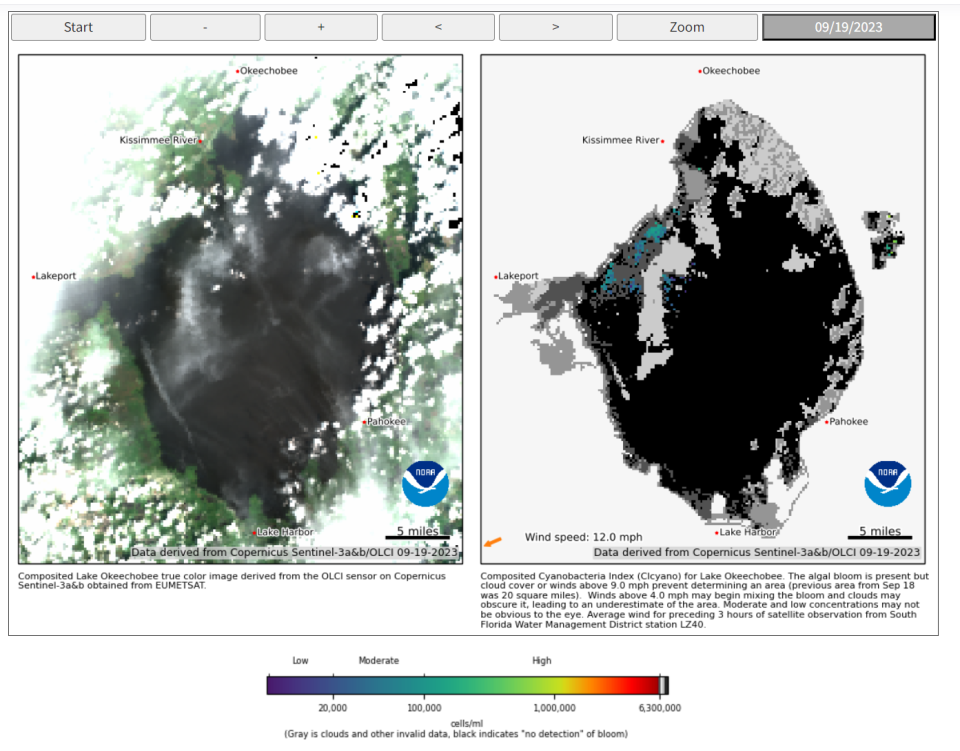Florida DOH issues advisory, but experts say blue-green algae concentrations are waning
It appears south Florida's 2023 blue-green algae season may over soon as water quality scientists say the organism that causes toxic outbreaks has run its course and is in remission.
The Florida Department of Health in Lee County Thursday issued a blue-green algae alert for waters surrounding the W.P. Franklin Lock and Dam, the U.S. Army Corps structure that separates the upstream freshwater portion of the river from the downstream estuary.
But overall, experts are saying we've likely reached the end of the blue-green algae season for this year as the organism that produces blue-green algae has likely run out of food.
"We've seen dramatic reduction (in blue-green algae), and it's the dissolved inorganic nitrogen that's been removed because of the bloom conditions that happened through the summer," said Lawrence Glenn, water resources director for the South Florida Water Management District, at a district board meeting last week.
Many national media outlets suggested this was a doozy of a year for Lake Okeechobee and the historic Everglades in terms of blue-green algae impacts, but this year's summer blue-green algae outbreak didn't create a nightmare scenario like the one that gripped the region in 2018.

Microsystis is the genus of freshwater cyanobacteria that causes what are called "blue-green" algae blooms in south Florida, and high concentrations can be dangerous to wildlife, domestic animals, pets and humans that are exposed to the toxins.
"We're starting to see changes in dominance (from microsystis) to a more mixed community of algae," Glenn said. "A lot of the low-level toxin production was important because that toxin is very nitrogen rich, so it's also using up that. We are in the downslope of the peak of blue-green algae season on Lake Okeechobee."
Blue-green concentrations are falling in other areas
The blooms have become more prevalent and prominent across much of the Sunshine State in recent years, since El Nino-driven rains dumped a foot a rain on the Lake Okeechobee in January of 2016 ― which led to a nasty blue-green algae bloom in the St. Lucie region.
A bloom with similar impacts hit the Fort Myers-Cape Coral area in the summer of 2018, and the region was under a state of emergency for blue-green algae and coastal red tide.
Thursday's DOH notice is not the first one issued this summer, but it seems blue-green algae concentrations are falling in places like Lake Okeechobee, often referred to as the liquid heart of the Everglades.
Conditions flared up at times this summer in the Caloosahatchee, especially in downtown Fort Myers.
The Florida Department of Health in Lee County issued a public advisory to warn people about that outbreak.
Satellite imagery tells the story
Florida Gulf Coast University professor and researcher Barry Rosen said earlier this summer that he wasn't seeing evidence of a large-scale toxic bloom.
"The best way to know is to look at satellite imagery. It shows there's hardly any out there," he told The News-Press a few weeks ago. "It doesn't seem to be a big bloom year for the lake."
More: Groups sue federal agency over Florida ghost orchid protections; agency mum on status update
Rosen and other scientists rely partly on the National Oceanic and Atmospheric Administration, or NOAA, satellite imagery to assess conditions on the lake.
NOAA's most recent imagery shows natural background conditions on about 90% of the lake, with low concentrations being found in the northwest section of Okeechobee.
Submerged grasses in Okeechobee are suffering
The grasses that filter the lake water and make up habitat for Okeechobee's famed largemouth bass fishery are suffering this year as water levels have been high all summer.
The U.S. Army Corps of Engineers has kept levels between 12.5 and 15.5 feet above sea level, but the grasses won't expand their range unless levels get to 12 feet or below.
"The lake just never drew down this year," said Paul Gray, a scientist for Audubon. "We're scheduled for a La Nina and that means a wetter than average wet season."
More: Riders on the storm: 5 animals besides flamingos that have been delivered to Florida
"And even if we have a normal year, getting down to 12 is hard especially when they're not making releases out of the lake," Gray said.
Okeechobee's aquatic vegetation was largely destroyed by Hurricane Ian, and now there is a scant 2,500 acres.
Glenn, the water district expert, said conditions are as bad as they've been since 2006, after a string of hurricanes in 2004 and 2005 wiped out large sections of grass in the lake.
"That is not enough in the lake," Glenn said. "And it doesn't provide the cleansing that the lake needs, and it doesn't provide the habitat that the lake needs. If we are able to get down to below 13 feet, 12-and-a-half would be wonderful in order to see some good requirement (for) next year."
Connect with this reporter: Chad Gillis on Facebook.
This article originally appeared on Fort Myers News-Press: Lake Okeechobee blue-green algae numbers declining: State scientist

